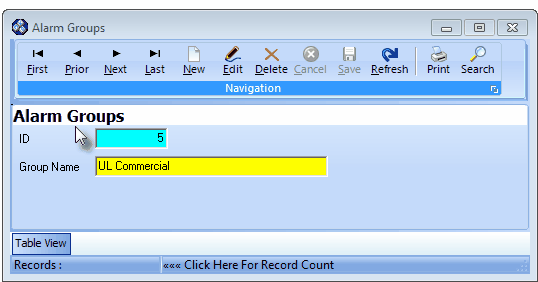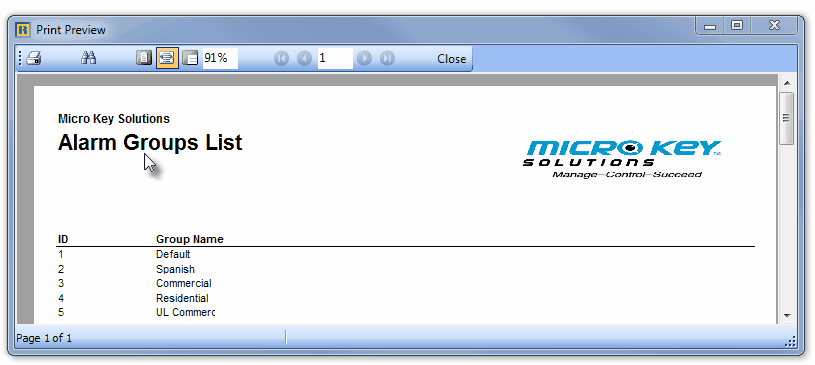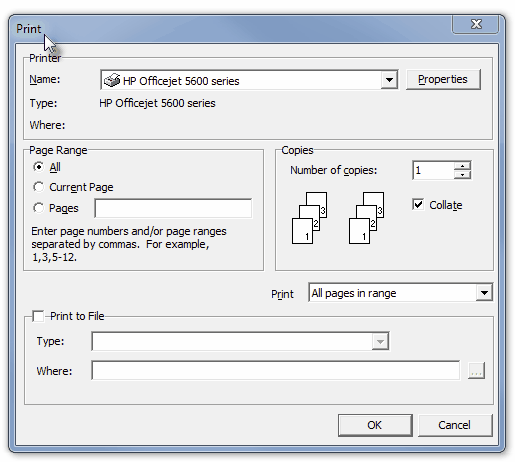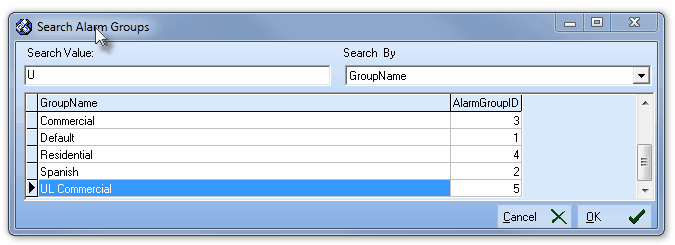| • | Assigning a Subscriber to an Alarm Group assures that the Subscriber's Alarm Signals are routed to Operators who: |
| ▪ | Will better understand the Type of Alarm System being monitored, |
| ▪ | Have the specialized Skills needed to properly handle their Alarm Signals, |
| ▪ | Speaks the language used by the person to which (s)he is currently responding. |
| • | Examples of an Alarm Group are Spanish Speaking, English Speaking, High Value Account, UL® Commercial, and Supervised for Open/Close. |
| ▪ | There is no limit to the number of Alarm Groups which may be defined. |
| ◆ | Important Note!: It is very important to remember that a Subscriber assigned to an Alarm (Processing) Group will not have their Active Alarm Signals processed unless at least one Operator - which has been assigned to that Alarm Group - is actively Processing Signals! Therefore: |
| a) | Until a specific requirement dictates otherwise, initially assign all Subscribers to the "Default" Alarm Group. |
| b) | At a minimum, also assign all Employees, whose Employee Type is either All or Operator, to the "Default" Alarm Group on the Alarm Groups tab of the Employee Form. |
| c) | Any number of additional Alarm Groups may then be assigned to each Operator, as the need arises, and the appropriate training has been completed. |
| □ | Alarm Groups Implementation Summary: |
| • | Any Subscriber that does not need to be specifically assigned to a special Alarm Group, should initially be assigned to the "Default" Alarm Group. |
| • | Initially, All Operators should be assigned to the "Default" Alarm Group within the Alarm Groups tab of the Employee Form. |

Employee Form - Alarm Groups tab
| • | Then, assign one or more other Alarm Groups to each Operator (within the Employee Form's Alarm Groups tab) who may be required to Process Alarm Signals transmitted from Subscribers assigned to one of those Alarm Groups . |
| • | At a minimum, the Operator must be assigned to the "Default" Alarm Group. |
| • | Active Signals received from the "Default" group may then be Processed by any available Operator logged in as a member of the "Default" group. |
| • | There is no limit to the number of Alarm Groups to which an Operator may be assigned. |
| □ | Defining the Subscriber Alarm (Processing) Groups based on the Operator's alarm processing Skill requirements, the Subscriber's locale or native language, or specific System Complexities (ex. UL®Commercial, High Risk Fire, Banks, etc.). |
| • | To enter Account (Processing) Groups, on the Main Menu Select Maintenance and Choose Central Station then Click Alarm Groups. |

Alarm Groups Form
| • | This Alarm Groups Form may be Re-sized by Dragging the Top and/or Bottom up or down, and/or the Right side in or out. |
| • | Navigation Menu - The Navigation Menu is located at the top of the Alarm Groups Form. |

| • | This Navigation Menu provides the normal Record Movement, New, Edit, Delete, Cancel, Save, and Refresh options; as well as special Print and Search functions. |
| • | Record Editing section - The details of the currently selected record are displayed below the Navigation Menu at the center (Main Body) of the Account Types Form. |
| • | Table View tab - A tabular (spreadsheet style) Table View of the currently defined Alarm Groups is accessible by Clicking the Table View tab at the bottom of the Account Types Form. |

| • | To display a specific Alarm Group record in the Record Editing section, Click on that record within the Table View section, or use the Search Icon (see the "Using the Special Functions" section later in this chapter). |
| • | This Table View information may be Pinned in Place by Clicking the Pin Icon on the right. |

Alarm Groups Form - with Table View tab Pinned Open
| ▪ | You may Un-Pin this Table View by Clicking the Pin Icon again. |
| ▪ | Click on any listed record to display that information in the center (Main Body) of the Form. |
| • | There are two columns of data in this Alarm Groups Record Listing: |
| 1) | Alarm Group ID - The record ID assigned by the system when the Alarm Group entry is originally saved. |
| 2) | Group Name - The description of the Alarm Group. |
| • | Each column's Header Name describes the data contained in that column. |
| ▪ | Clicking on a Header Name will set the order in which the Alarm Groups will be listed. |
| ▪ | Clicking on the same Header Name will set the order in the opposite direction (ascending vs. descending). |

| ▪ | The Header Name that is determining the Order of the list will have an Icon indicating the Order displayed next to that Header Name. |
| • | To define the Alarm Groups which will help assure that a Subscriber's Alarm Signals are routed to Operators that have the training (or other capabilities) which enable the Operator to properly Process those Signal. |
| • | Click the  Icon to start a Alarm Group entry in the Record Editing section. Icon to start a Alarm Group entry in the Record Editing section. |
| ▪ | ID - This number will be assigned when the Alarm Group's description is initially saved. |
| ▪ | Group Name - Enter a brief description of up to 50 characters in length for this Alarm Group. |
| o | The Description may up to 50 characters in length and include upper and/or lower case letters, numbers, spaces and normally used punctuation marks. |
| • | Click the  Icon to to record this Alarm Groups. Icon to to record this Alarm Groups. |
| • | Any number of additional Alarm Groups may be created. |
| □ | Using the Special Functions on the Navigation Menu at the top of the Alarm Groups Form: |
| • | Print - Click the Print Icon to View and/or Print a list of the Alarm Groups. |

| • | Yes - Click the Yes button to View a copy of the report. |

| • | No - Click the No button to open the Windows® Print dialog where a copy of the report may be sent to a selected Printer, or Printed to a File. |

| • | Cancel - Click the Cancel button to close this Print question and return to the Form. |
| • | Search - Click the Search Icon to open the Search Alarm Groups dialog. |

Search dialog
| • | See the "Using the Generic Search dialog" section in the Advanced Search Dialog chapter for more information about this Search dialog. |











![]()

![]()



